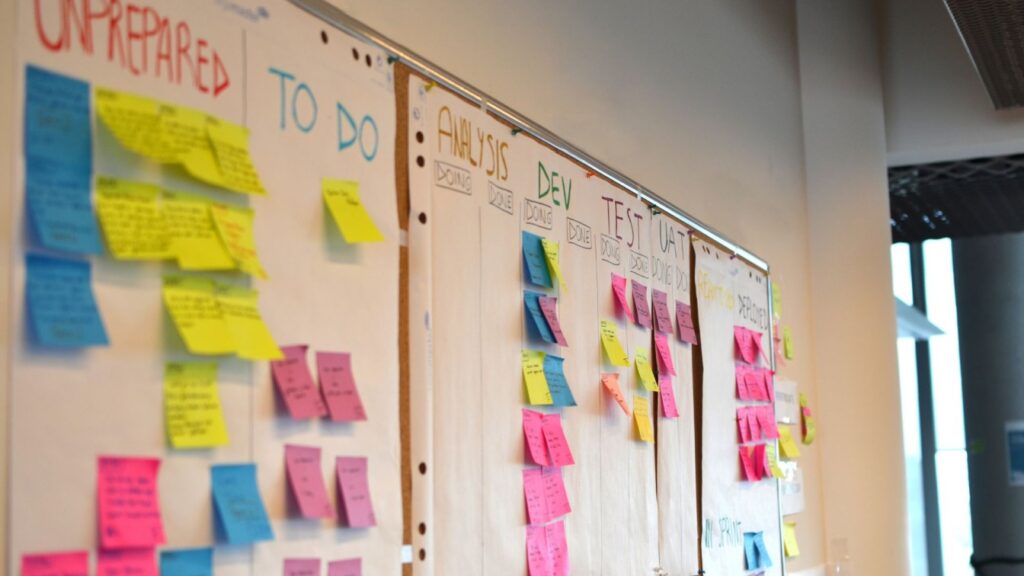Kanban board for development. This video explains 3 important points for using the Kanban Methodology for product development. The video is inspired by a post written by Stefan Stojković about Lean Kanban. If we speak about Kanban usage as a methodology for product development then we must make sure we are using it properly.
Table of Contents
ToggleLimit WIP with the Kanban board
Limiting Work in Progress (WIP) with the Kanban board is a powerful strategy that streamlines workflows, enhances focus, and fosters collaboration. By constraining the number of tasks to one or two per person, teams concentrate on the most critical items, ensuring efficiency and clarity. This section explores the multifaceted benefits of WIP limitation in a Lean Kanban environment.
- Streamlining Workflow: Limiting WIP directs attention to priority tasks, enabling teams to complete them more swiftly and effectively. This streamlined approach not only speeds up individual tasks but also accelerates the overall project timeline.
- Reducing Context Switching: Juggling multiple tasks often leads to diminished focus and productivity. By limiting WIP, team members dedicate their full attention to a small number of tasks, drastically reducing the time and mental load involved in switching between different activities.
- Exposing and Resolving Blockers: A limited WIP load makes it easier to spot and address workflow impediments. Teams can quickly identify bottlenecks and collaborate on solutions, maintaining a smooth and uninterrupted workflow.
- Encouraging Frequent Value Delivery: With a focus on completing a few tasks at a time, teams can deliver value more frequently. This approach leads to quicker iterations, allowing for ongoing refinement and enhancement based on real-time feedback.
- Enhancing Feedback Loops: Smaller batches of work result in quicker turnaround times, leading to faster feedback from stakeholders. This rapid feedback loop enables teams to learn and adapt swiftly, continually improving the quality and relevance of their work.
- Increasing Predictability: A limited number of tasks in progress at any one time makes it easier to forecast completion times and manage expectations. This predictability is crucial for effective planning and resource allocation.
- Fostering T-Shaped Skill Development: Limiting WIP encourages team members to broaden their skill sets. This development of T-shaped skills promotes versatility within the team, enabling members to support a wider range of tasks and projects.
- Improving Team Morale and Reducing Burnout: A manageable workload leads to higher team morale and reduces the risk of burnout. By focusing on a smaller set of tasks, team members experience a greater sense of achievement and job satisfaction.
- Optimizing Resource Use: By concentrating on a limited set of tasks, teams make more efficient use of their resources. This focused approach ensures that resources are not spread too thin, leading to better overall performance.
- Fostering Team Collaboration and Communication: When working on a few tasks, team members naturally collaborate more closely. This enhanced collaboration fosters a team environment where communication is clear, and problem-solving is collective.
- Adapting to Change with Agility: In a fast-paced work environment, the ability to quickly adapt to change is crucial. By limiting WIP, teams can swiftly respond to new information or changing priorities, ensuring that their work remains relevant and effective.
Starting Kanban Board with Just in Time
Starting just in time is a pivotal concept in Lean Kanban, emphasizing the importance of timing in initiating tasks or features. By deferring the start of each feature until the latest feasible moment, teams gain several significant advantages, which are elaborated upon below:
- Reducing Premature Commitment: Starting just in time means avoiding premature commitment to tasks or features. This approach allows teams to remain flexible, adapting to new information or changing priorities without being burdened by work that may no longer be relevant.
- Enhancing Feature Clarity: Delaying the start gives more time for the refinement and clarification of features. With this extra time, teams can better understand the requirements and nuances of each feature, leading to a more effective and accurate implementation.
- Increasing Feedback Opportunities: This approach provides additional opportunities to gather and incorporate feedback. By waiting to start, teams can consult more extensively with stakeholders, ensuring that the work aligns closely with their needs and expectations.
- Optimizing Resource Allocation: Starting just in time helps in optimal resource allocation. Teams can prioritize resources for the most immediate and impactful tasks, ensuring that efforts are concentrated where they are most needed.
- Minimizing Context Switching: By focusing on fewer, more immediate tasks, team members face less context switching. This focus enhances productivity and reduces the cognitive load associated with juggling multiple, potentially conflicting priorities.
- Avoiding Rework and Redundancy: Starting later can reduce the likelihood of rework. As teams have more time to understand the full context and requirements, they can avoid the pitfalls of rushing into tasks that might need significant changes later.
- Balancing Workloads: This method aids in balancing workloads across the team. By delaying the start of new tasks, teams can ensure that they are not overburdened, promoting a more sustainable and manageable work environment.
- Facilitating Better Planning: With a just-in-time approach, planning becomes more dynamic and responsive. Teams can adjust their plans based on the latest information and insights, leading to more effective and efficient workflows.
- Reducing Inventory and Waste: In Lean terms, work that is started too early can be seen as a form of inventory. By starting just in time, teams reduce this ‘inventory’, minimizing waste and ensuring that efforts are focused on current, value-adding activities.
- Encouraging Proactive Problem Solving: This approach encourages teams to be more proactive in problem-solving. With a clearer understanding of the tasks at hand, teams can foresee potential issues and address them before they escalate.
Balancing Small Batches and Fixed Costs
Balancing small batches and fixed costs is a critical aspect of implementing Lean Kanban effectively. It involves a strategic approach to managing workflow and resource allocation. This section delves into the nuances of finding the right balance between batch processing and one-piece flow, emphasizing the importance of maintaining a steady workflow and the implications on fixed costs.
- Understanding When to Batch: It’s essential to recognize scenarios where batch processing is more efficient than one-piece flow. Certain tasks, due to their nature or the resources they require, might be more effectively completed in batches. This approach can maximize resource utilization and reduce setup times.
- Avoiding Oversized Batches: While batching can be beneficial, overly large batches can hinder the flow of work. They can lead to bottlenecks, increased lead times, and reduced responsiveness to changes. It’s crucial to find the optimal batch size that balances efficiency with agility.
- Maintaining Workflow Consistency: The primary goal is to ensure a consistent and smooth workflow. This consistency is key to achieving a steady pace of delivery, which is central to the Kanban methodology. Disruptions in the flow can lead to delays and inefficiencies.
- Impact on Automation Investments: When the flow of work is interrupted, often the solution involves investing in automation to streamline processes. However, these investments should be carefully considered. Automation can reduce fixed costs in the long run, but it also requires significant upfront investment and can lead to increased complexity.
- Evaluating Fixed Costs: In the context of balancing batches and flow, it’s important to continually assess fixed costs. These costs, which do not change with the volume of work, can be optimized through more efficient workflow management.
- Adapting to Demand Fluctuations: The ability to adapt batch sizes in response to changing demand is crucial. This flexibility ensures that the team can respond quickly to new requirements or shifts in priorities.
- Feedback and Continuous Improvement: Regular feedback on the effectiveness of the batching strategy is vital. This feedback allows for continuous improvement and adjustments to batch sizes and workflow processes.
- Training and Skill Development: Effective batching often requires specific skills and knowledge. Investing in training and skill development ensures that team members can make informed decisions about batching and workflow management.
- Measuring and Monitoring Performance: Key performance indicators (KPIs) should be used to measure the impact of batching on workflow and costs. These metrics will guide decision-making and help identify areas for improvement.
- Collaborative Decision-Making: Decisions about batching and flow should involve input from the entire team. Collaborative decision-making ensures that different perspectives are considered, leading to more effective strategies.
- Scalability and Flexibility: The chosen approach should be scalable and flexible, allowing for adjustments as the team or project evolves. This adaptability is crucial in a dynamic work environment.
Conclusions
the Kanban Board stands as a testament to the philosophy of continuous improvement and efficiency in workflow management. Jez Humble’s adage, “If it hurts, do it more frequently, and bring the pain forward,” aptly encapsulates the essence of what the Kanban Board aims to achieve.
During my 20 years of experience as a Lean Expert and Trainer, I have seen many Lean Journey … some of them failed but some of them brought people and companies to incredible results. I always liked to teach others and I am happy when they have success.
This is the reason why I started in 2010 with my first website on Lean and by continuous improvement, I decided to found LeanVlog.







